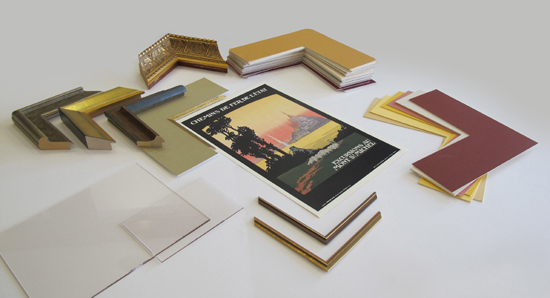Design
We will make sure your frame design is perfect for your art and the decor in your home or office. Every framing decision begins with your personal tastes, your style, your likes and dislikes and where the piece is going to hang. We will show you a selection of mats and frames that will best enhance your art. Depending on the piece, we might suggest using a combination of mats,a fillet or a liner to enhance the artwork for a more dramatic look. The choice of frame, from ornate classic and traditional to simple modern styles will be tailored to fit your art, and your taste. We will help you choose the perfect glass or acrylic glazing to protect and display your piece.
Keep in mind, your art will always look best if it is framed for the art and not for the room it will be going in. Your decor may change over time or you may decide to move the piece of art one day.
Detailed or busy art pieces are best displayed in simple frames so that the art becomes the prime focus whereas simple art, or not so busy art, and oil paintings are enhanced through more ornate frameing choices.
Mats
The easiest way to ensure that you select the right colors for a piece of artwork is to bring it in to our store so that we can work with you to select a color harmony that complements the artwork. While there are no unbreakable “rules”, the guidelines shown below will provide the most pleasing resultswill tend to produce a pleasing combination:
- Top mats should be fairly neutral in color and have the same basic value (lightness or darkness) as the overall artwork, or the background of the composition.
- Select an accent color to use for the second mat. A good choice for the accent color would be the color of a focal point in the subject matter of the artwork. Or, the third most predominant color in the artwork tends to make a good choice for an accent color. The second mat is there for impact and contrast, so it will generally be a more intense color than the top mat, and usually of contrasting value with the background of the artwork as a whole. This approach is one of the most commonly used in creating a basic double mat design. If you would like to add still more interest, you can use a third mat in between these two layers in the same color family (or the complementary color family) of one of the other mats, in a midrange value, or tone. The exposure, or amount of this mat layer showing, should be somewhat larger or smaller thanthe bottom mat exposure to prevent a monotonous “stripe” effect.
In framing design, there are very few “rules”, although there are some guidelines. In general, the best mat border width is determined by a number of factors, including the overall size of the piece, the width of the moulding, and the particular hue and value of the mats and the art. The goal is to attempt to give the art enough “space” inside the frame to allow the eye to rest upon the art without being distracted or crowded in by the framing. In most cases, you will want your mat to be appreciably wider than the moulding: A mat that is much narrower than the moulding ends up looking like an afterthought, or a way to force a picture into a frame of the incorrect size. A mat that is the same width as the moulding can be visually unsettling; it is more attractive to have some variety in the design, and avoid the visual monotony of repetitive widths. As a rule, a mat that is approximately 2/3 of the total width of the combination of mat and frame, (or about twice the width of the frame).
Glass
We provide several basic types of glass and acrylic. The glass selections include: Premium Clear; Conservation Clear® with TruGuard® Protection, which blocks 98% of harmful Ultra Violet (UV) light rays, Reflection Control®, which is single sided etched non-glare glass; and Museum glass, which virtually eliminates glare. Acrylic is available in Premium Clear, regular, Conservation Clear with 98% UV protection, and Reflection Control, which minimizes reflection and Optium™ Acrylic which has the anti-reflection technology. We display framed art using these various types of glazing. We will show you samples of all the choices available and help you to pick the option that best suits your framing project.
Conservation
There are several elements involved in preservation framing that will help to maintain the condition of your item. The glazing (glass or acrylic) should have UV-protective properties to help prevent damage to your item from ultraviolet light. The glass should be spaced away from the surface of the art, which is usually accomplished through the use of matting. The matting and backing materials should be preservation-grade, acidand lignin-free, and the artwork should be mounted in a reversible manner to the backing.

